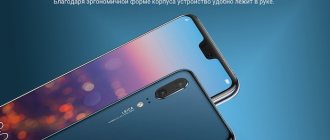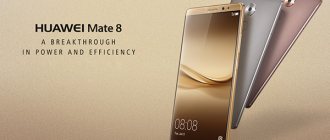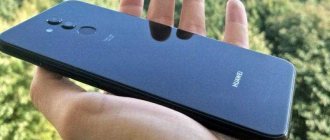Review of the Huawei Mate 10 Pro smartphone and its characteristics
Nowadays, a powerful processor, frameless design and a huge amount of built-in memory will no longer surprise anyone; not only every flagship, but even mid-price devices can boast of this.
A modern smartphone has a performance reserve for at least several years ahead and can easily cope with any tasks, but where to go next? After all, we need to somehow develop the industry, and every year it becomes more and more difficult to offer something new. The hero of our review is Huawei Mate 10 Pro, in which the manufacturer offered something truly new that we have never seen anywhere else - a smartphone that will only get better every year, self-learning and adapting to the user’s needs. Let's review the Mate 10 Pro and see what such an unusual solution is really capable of.
Battery
Mate 10 and Mate 10 Pro are equipped with 4000 mAh batteries that support fast charging. When the device is turned off, it takes only 26 minutes to charge from 0% to 50%, and a full charging cycle is no more than 90 minutes. This speed is very impressive, considering that the battery of the above devices has a capacity of about 1000 mAh more than the batteries of many other smartphones.
The situation changes in a completely different direction when it comes to battery discharge. With very intensive use, the Mate 10 can stay afloat for 6 hours. With battery optimization settings enabled, the phone will give you 5 hours of use throughout the day, with 50 percent remaining charge.
Technical characteristics of Huawei Mate 10 Pro:
- Screen: OLED, 6″, 2160×1080 (402 ppi), HDR10
- Processor: eight-core HiSilicon Kirin 970, (4 x 2.36 GHz + 4 x 1.8 GHz), integrated neuroprocessor module
- Graphics accelerator: Mali-G72 MP12
- Operating system: Android 8.0 Oreo with EMUI 8.0 firmware
- RAM: 6 GB
- Built-in memory: 128 GB
- Memory card support: no
- Communication: GSM 850/900/1800/1900 MHz || UMTS 800/850/900/1700/1900/2100 MHz || LTE: 1, 2, 3, 4, 5, 6, 7, 8, 9, 12, 17, 18, 19, 20, 26, 28, 32, 34, 38, 39, 40
- SIM: 2x nano-SIM, Dual SIM Dual Standby (DSDS)
- Wireless interfaces: WiFi 802.11 b/g/n/ac, Bluetooth 4.2, infrared sensor, NFC
- Navigation: GPS, GLONASS, BeiDou
- Main camera: main - 20 MP (monochrome) + 12 MP (RGB), f/1.6, optical stabilization, flash, phase detection and laser autofocus, continuous autofocus during video shooting (CAF)
- Front camera: 8 MP, f/2.0
- Sensors: light, motion, microgyroscope, accelerometer, magnetometer, barometer, fingerprint sensor
- Water and dust protection: IP67
- Battery: 4000 mAh, non-removable, Huawei SuperCharge fast charging
- Dimensions: 154.2x74.5x7.2 mm
- Weight: 178 grams
Comparison of the best camera phones Xiaomi Mi 10 Ultra vs Huawei P40 Pro
In August 2021, Xiaomi Mi 10 Ultra was released, a new smartphone in the anniversary flagship line.
Mi 10 Ultra became a sensation from the moment it appeared - easily pushing our second champion, the Huawei P40 Pro smartphone, from the leading position in photo tests, and secondly in terms of technical equipment with RAM up to 16 GB and ultra fast charging up to 120W. Mi 10 Ultra is currently the most powerful Xiaomi smartphone.
In addition to impressive innovative technological solutions, the obvious advantages of the Xiaomi Mi 10 Ultra include the price. The minimum price for Xiaomi Mi 10 Ultra will be $650. This is not a purchase for every day, especially during the global crisis.
Huawei P40 Pro was released in March 2021 and held the lead in all parameters of mobile photography for quite a long time. The minimum price of Huawei P40 Pro is about $1,000. For Russia and Europe, the minimum price of Huawei P40 Pro starts at $1,300. Almost twice as expensive, although in difficult conditions and in the presence of problems with international software (Google services ban for Huawei), it would be more logical to reduce prices.
Let's compare the parameters of smartphones in more detail
Design and convenience
The Mi 10 Ultra version was a return to tradition with the option of a translucent body design. Transparent Edition is really cool. Moreover, in the new version the lid is indeed transparent. 2 more designs of Mi 10 Ultra – shining black and silver. The silver version is only available in the maximum configuration.
The photoblock is made in a ruler format with a 120 zoom lens highlighted by a frame. The powerful LED flash is thoughtfully placed at the top of the photo unit - there is less chance of covering it with your palm when shooting.
Traditional Android 10 software with MIUI shell + full international services, instant messengers, updates, and so on.
With the Huawei P40 Pro, things are not that simple. The design is impeccable, except for the traditional microscopic increase in the gap in the middle part of the smartphone. This is not a flaw - this is how a metal stiffener works.
Huawei P40 Pro traditional colors: Black, Blush Gold, Silver Frost. The photoblock module has been increased as expected - very high-quality sensors have been installed.
The camera sensors are widely spaced and take up quite a lot of space.
There is support for an external memory card - a rarity for new flagships. But again, there are nuances. It is necessary to note the excessively high requirements for memory cards. Only branded proprietary cards are used, the format is identical to nanoSIM. Memory card capacity up to 256 GB. Branded cards are more expensive than regular ones, support exFAT format (cannot be used as a main drive, but application data can be stored)
There is a limitation on using Bluetooth 5.1 - aptX and aptX HD codecs are not supported (SBC, AAC, LDAC and LHDC are available).
Android 10 and proprietary EMUI 10.1 shell with support for Huawei AppGallery are installed.
How Huawei P40 Pro bypasses Google service bans
Political squabbles, unfortunately, objectively affected the capabilities of the Huawei P40 Pro. The lack of any Google services for an Android smartphone is a very serious disadvantage for users.
The program for installing additional applications Huawei AppGallery (an alternative to Google Play) does not support downloading and installation of instant messengers and social networks.
To copy existing profiles, you can use the Phone Clone program (works flawlessly on Huawei smartphones).
The WhatsApp application can be installed independently from the developer’s website (without the possibility of updates).
The Amazon App Store application will help you install Facebook, Signal and Threema instant messengers.
In general, it is possible to overcome the system of prohibitions and restrictions. But you will have to spend much more time and, perhaps, use the help of specialists.
We wish Huawei to overcome the problems associated with trade restrictions as soon as possible, but we cannot help but note the fact that the Huawei P40 Pro lacks the usual services. Although, if you think about it, Huawei doesn’t really feel sorry for us, pricing its flagships at $1000-1600.
Xiaomi Mi 10 Ultra without unnecessary problems with any international services looks preferable.
Screens
Xiaomi Mi 10 Ultra 6.67-inch screen with 120 Hz refresh rate + 270 Hz discrete layer refresh rate. The matrix is made by China Star Optoelectronics. HDR10+ format is supported, MEMC support for dynamic scenes without blur. Screen resolution 1080x2340. The edges of the screen are curved with a lens effect, and the glass is protected from scratches. The cutout for the front camera is compact, without darkening. An excellent flagship screen with the most advanced technology.
The Huawei P40 Pro's 6.58-inch screen with a resolution of 1200×2640 is slightly behind in terms of refresh rate – 90Hz. Also a good screen, although I would like to move the 2 front cameras to another place.
Fingerprint sensors in both cases are built into the screen.
You simply won’t see the difference in screen refresh rate. Only in games and graphic applications with highly dynamic updates. But it’s still nice when the performance is maximum. Objectively, the Xiaomi Mi 10 Ultra screen is better.
Iron
In terms of performance and synthetic AnTutu tests, it is useless to compete with the Xiaomi Mi 10 Ultra. The fastest Qualcomm Snapdragon 865 chipset and Adreno 650 video are installed (there is also a Qualcomm Snapdragon 865+, but it went to the Black Shark, the best gaming model) and 16 GB (!) of super-fast LPDDR5 RAM. Hard drive up to 512 GB UFS 3.1.
The results of Xiaomi Mi 10 Ultra on AnTutu are above 600 thousand points.
Huawei P40 Pro is equipped with Huawei's proprietary HiSilicon Kirin 990 5G processor and ARM Mali-G76 MP16 graphics. RAM 8 GB LPDDR4 format. Hard drive up to 512 GB. According to AnTutu, Huawei P40 Pro is expected to score about 500 thousand points. An excellent indicator, if not for comparison with the much more powerful Xiaomi Mi 10 Ultra. A difference of 100,000 points is an insurmountable gap. Although in standard applications the difference in performance will not be noticeable at all. Only when running powerful games, graphics applications, video editing, photo editing and streaming modes.
Support for 5G and Wi Fi 6 in both cases is implemented at the processor level.
In terms of hardware and power, the Xiaomi Mi 10 Ultra wins, although a more powerful cooling system would be nice. When fully loaded, the smartphone gets noticeably warm. But let's be honest, actually booting up the Mi 10 Ultra is quite difficult.
Cameras
Independent testers from DxOMark rated the Huawei P40 Pro cameras at 128 points and the Xiaomi Mi 10 Ultra cameras at 130 points, setting a new record. But let's be honest, the difference of 2 points is not very significant, although the AI of the Xiaomi Mi 10 Ultra does perform better. In both cases, excellent color rendition, detail, low-light shooting and excellent optical stabilization are implemented. The main camera of Xiaomi Mi 10 Ultra also supports 120x combined zoom.
Main photo unit of Xiaomi Mi 10 Ultra
- 48 MP OmniVision OV48C 1/1.32" Quad Bayer, f/1.85, PDAF, OIS
- 12MP Samsung S5K2L7 portrait lens 1/2.56" telephoto, f/2.0, dual pixel autofocus +2x optical zoom
- 48 MP Sony IMX586 Quad Bayer f/4.1 telephoto lens, PDAF, OIS (5x optical)
- 20 MP Sony IMX350 1/2.8" ultra-wide angle, f/2.2, PDAF
- Front camera 20 MP f/2.3.
4K 60fps video, 8K 4320p 30fps video – all with optical stabilization.
Photoblock Huawei P40 Pro
- 50 MP, f/1.9, 23mm (wide angle), 1/1.28", 2.44µm, omnidirectional PDAF, OIS
- Periscope 12 MP, f/3.4, 125mm (telephoto), PDAF, OIS, 5x optical zoom
- 8 MP 1/1.54", PDAF TOF 3D
- 40 MP, f/1.8, 18mm (ultra-wide angle)
- The front camera is dual, 32 megapixels.
Each set can have its own pros and cons, but here it’s easier to turn to DxOMark experts, who have already done all the work on a detailed analysis of all photo and video parameters.
According to subjective opinion, the Xiaomi Mi 10 Ultra cameras work better with lighting, paying more attention to problem areas and making up for lighting deficiencies using powerful AI. In reality, it’s more convenient and familiar for everyone. The quality of the cameras is excellent, at a good professional level - you can shoot videos, make your own clipart and references, sell photo and video content.
Battery
Xiaomi Mi 10 Ultra received fantastic fast charging of 120 W (adapter included) and the ability to charge in minutes. 41% in 5 minutes and 100% in less than half an hour. Battery capacity 4500 mAh. Supports 50W wireless charging and 10W reverse wireless charging. An unprecedented technological solution at the moment. We applaud without further comment.
Huawei P40 Pro is equipped with a 4200 mAh battery, fast wired and wireless charging of 40 W, and fast reverse charging of 27 W. Good parameters, although not comparable to Xiaomi Mi 10 Ultra.
Comparison table of characteristics of Mi 10 Ultra and P40 Pro
| Xiaomi Mi 10 Ultra | Huawei P40 Pro | |
| Weight and dimensions | 75 x 162.4 x 9.4 mm, 222 g | 72.6 x 158.2 x 9.0 mm, 209 g |
| CPU | Qualcomm Snapdragon 865, Adreno 650 | Huawei HiSilicon KIRIN 990, ARM Mali-G76 |
| Screen | 6.67″, AMOLED, 2340 x 1080, 386 ppi, 800nt | 6.58″, AMOLED, 1200 x 2640, 441 ppi |
| Battery | 4500 mAh, 120 W, wireless and reverse charging | 4200 mAh, 40 W, wireless and reverse charging |
| Main camera | 48 MP (Omnivision OV48C, ƒ/ 1.85) + 48 MP (telephoto, Sony IMX586, ƒ/ 4.1) + 20 MP (wide-angle, Sony IMX350, ƒ/ 2.2) + 12 MP (portrait, Samsung S5K2L7, ƒ/ 2.0) | 52 MP (Sony IMX700, ƒ/ 1.9) + 40 MP (Sony IMX650 Exmor RS, ƒ/ 1.8) + 12 MP (ƒ/ 3.4) |
| Front-camera | 20 MP (Samsung S5K3T2, ƒ/ 2.3) | 32 MP (ƒ/ 2.2) |
| Memory options | 8/128, 8/256, 12/256, 16/512 GB | 8/128, 8/256, 8/512 GB |
| NFC availability | Yes | Yes |
| Audio Jack 3.5 mm | No | No |
| Fingerprint's scanner | Subscreen | Subscreen |
| Colors | Black, white, transparent | black, blue, white |
| Price | from 65,000 rub. | from 75,000 rub. |
Verdict
Xiaomi Mi 10 Ultra is a real, de facto leader in all respects, which is recognized even by relatively objective opponents.
For people in creative professions, for whom a smartphone with excellent cameras, speed and capacious fast charging is necessary as a working tool, we recommend paying close attention to the Xiaomi Mi 10 Ultra.
Huawei P40 Pro is a very good smartphone, but somehow too confidently moving towards self-isolation. If you are a fan of Huawei and are ready to pay twice as much for humanitarian reasons, we won’t try to convince you otherwise. But even Huawei fans have to admit that the prices and specifications of the smartphones make the Xiaomi Mi 10 Ultra a better buy.
Why Xiaomi Mi 10 Ultra is better
- The power is significantly higher, more modern technologies are used
- More modern screen refresh rate standard
- Best photoblock
- Larger battery with 120W fast charging
- There are no problems with international services, software, updates and instant messengers.
Innovative features of Huawei Mate 10 Pro
Huawei Mate 10 Pro became the world's first phone to have a neural computing module built into its processor. It is involved in processing requests related to neural networks, artificial intelligence, and machine learning. In this way, the processor adapts to the user’s needs and over time will cope even better with the tasks assigned, which opens up great prospects for the future.
Neural networks are needed primarily for photographs, where they have been used for quite some time to determine the face in front of the camera lens. Few people know, but they are the ones responsible for this function, which we use every day when photographing ourselves and loved ones. Thanks to the dedicated NPU, Huawei was able to obtain a significant increase in the speed of the neural network and expand the possibilities of its use.
Now the “Camera” application is able to automatically determine the scenario or object in the frame: pet, person, plant, porter, low light conditions and much more, depending on which exposure and white balance are adjusted. During our review of the Mate 10 Pro, we thoroughly tested the new algorithms and can say with confidence that they work correctly.
The review of the Huawei Mate 10 Pro smartphone informs you that when the neural network sets the optimal shooting scenario, a special icon in the lower left corner warns you about this. It takes a split second to process the image and select the ideal parameters for shooting. Before you know it, you can start shooting. In advanced mode, you can quickly receive information about changing settings. They are ideal for capturing whatever is currently in the frame. In addition, neural networks are involved in creating photographs with the Bokeh effect, which has a positive effect on their quality.
Another area of application of neural networks is communication. The Huawei Mate 10 Pro phone received VoLTE support for each SIM card. The neural network analyzes the conversation and immediately removes extraneous noise, which improves audibility for both interlocutors.
Another interesting feature that the Huawei Mate 10 Pro Porsche Design review revealed is the translation. The manufacturer joined forces with Microsoft, resulting in the Translate application, which, with the help of neural networks, produces high-quality text translation in dialogue mode, by voice typing or from the keyboard. So far, the quality of this function leaves much to be desired, but thanks to self-learning, over time the system will begin to better understand the text. But now we can already note the lightning speed of translation, which is especially convenient in conversation.
As the Huawei Mate 10 pro 6 review showed, in addition to the above, neural networks take an active part in optimizing the consumption of system resources, including RAM and power consumption. They customize the smartphone so that it best suits the user's needs. During our review, we were able to find out that at the moment NPU is not using its full potential, but this is a good foundation for the future, which will still receive active development and a lot of new opportunities. The manufacturer is not going to stop there. In the future, the efficiency of the hardware of the Huawei Mate 10 Pro 64 GB phone will increase significantly due to the invention of new algorithms, self-learning neural networks and other solutions from other manufacturers, because the platform is open to third-party developers.
Good cameras
The peculiarity of the smartphone is that it has 4 cameras at once. The main one is 16 megapixels plus a 2 megapixel auxiliary module, the front one is 2 megapixels and 13 megapixels. First of all, additional camera modules have been added to make it possible to create a blur effect in the background of photos. Both cameras can shoot with this effect. In addition, it can be used when creating live photos, when a video segment of a couple of seconds is recorded along with the photo.
Let's talk in more detail about the main camera. As already mentioned, it received a resolution of 16 megapixels. The pictures taken with its help are of high quality. The Huawei Mate 10 Lite's camera takes excellent pictures in good street lighting, as well as on a cloudy day. However, if you decide to take pictures at night, the quality will drop slightly due to noise, but for this price category this is not critical.
As for the notorious blur effect, which is achieved through the use of two cameras, it turns out to be of surprisingly high quality. However, you need to keep an eye on the distance of the focusing object, otherwise a decent photo will be at risk.
The Camera application has quite standard settings; you can select various effects and configure them manually, as well as select the photo quality.
In general, the smartphone is good for taking photographs, but it falls just short of the Xiaomi Mi Mix (its main competitor in the price category).
The front camera is also of excellent quality; pictures with it are decent even in average lighting, but when shooting at night, the quality also drops. The front camera boasts some special effects. For example, one of them is designed to improve the face, giving it smoothness. The function does not work very realistically, but it will find its fans. The blur effect finds special implementation in selfie shots. Portraits add some flair.
To summarize, we can say with confidence that the cameras of Huawei Mate 10 Lite turned out to be decent; they are perfect for both regular photographs and selfie shots.
Equipment
The Huawei Mate 10 smartphone comes in a package with a minimalist design: the cover design is complemented by ribbed stripes, and a line with the model name runs down the center. Below it we see a bright spot with the Leica logo. We placed the device on top of the box, it lies in a removable container. Underneath we find two boxes. On the left there is documentation, a silicone bumper and a paper clip, and on the right there is a USB Type-C cable, a charger and a headset. Already from the factory, a protective film is glued to the display. The manufacturer abandoned the standard 3.5 mm jack, and therefore an adapter is included in the kit.
Design of Huawei Mate 10 Pro
Recently, the manufacturer has switched to producing devices with minimal frames around the display. But in 2k17, many are trying to abandon them altogether, and of course they did not forget about this when developing the Mate 10. We are offered a smartphone with the largest possible display in a compact case made of premium materials. As a result, with a 6-inch diagonal, the dimensions are comparable to the 5.5-inch P10.
The Huawei Mate 10 review showed that when developing this model, the manufacturer used the design concepts of its predecessors; no one began to completely revise the design style. But there are certain changes in terms of design; it has become more vibrant and expressive.
This primarily concerns the back, on which two main cameras are located one above the other, flanked by an LED flash and laser autofocus.
Between them and the fingerprint scanner there is a strip that changes color depending on the angle at which you look at it. This makes the smartphone more impressive and recognizable.
There is no need to worry about the safety of the back side; it is covered with protective glass Gorilla Glass, under which there are 4 layers of film, which is responsible for the formation of color. Thanks to this feature, the color of the backdrop changes depending on how the light falls on it. Buyers can choose from four color options for the Mate 10 case: blue, grey, brown and rose gold.
The front panel almost completely copies the design of last year’s flagship Mate 9. The manufacturer didn’t bother making glass that curved at the edges and in vain, in our opinion, the device would have looked better that way. The display is flat, but despite this it has an aspect ratio of 18:9, which distinguishes it from its competitors. Overall, the device looks beautiful and symmetrical. All the basic elements of the body are located on the same line; small frames of equal size are left above and below the display.
The case received IP67 protection against moisture and dust, which allows it to withstand immersion to a depth of up to a meter below the surface of the water without the slightest damage.
On the left there is a tray for a pair of SIM cards.
The right side is occupied by a volume rocker and a power button.
At the top is an IR port for controlling household appliances, as well as a main noise-canceling microphone.
At the bottom is a USB Type-C port, flanked by a microphone and speaker.
Huawei Mate 10 Pro review informs you that a fingerprint scanner is installed on the back side. It works quickly - the screen unlocks as soon as you put your finger on it. In the settings you can enter up to 5 different fingerprints.
Software
The Mate 10 runs Android 8.0 Oreo, paired with Huawei's proprietary EMUI skin, which has both fans and critics. The eighth version of this interface is a good update and introduces the main features of Oreo. The Mate 10 processor includes a Neural Processing Unit (NPU) that should benefit future applications, but it's too early to draw any conclusions.
Those of you who are already familiar with Huawei's user interface won't see much new. One of the most interesting features that the hero of our review offers, in addition to the ability to use it as a computer, is the ability to duplicate applications with different accounts. On the Mate 10, you can use the fingerprint scanner as a replacement for the on-screen navigation keys. Swipe it to the right to start multitasking. Swipe left to go back. By the way, this feature does not work as well as Motorola's versions, but it is a good solution for better use of the display. If you keep the start button pressed, the handy Google Assistant digital assistant will be available to you.
Display
Huawei Mate 10 Pro display review shows that it has a high-quality OLED matrix with a diagonal of 6 inches and support for HDR10 technology. With standard settings, it works at a resolution of 2160x1080, but to improve battery life you can set it to 1440x720 at any time.
While reviewing the Huawei Mate 10 lite 4 64gb, we learned that the system's capabilities allow you to minimize color saturation in order to minimize eye strain. If the factory calibration of the Mate 10 screen does not suit you in any way, then in the settings you can set your color temperature parameters. We haven’t forgotten about the now popular “Eye Protection” mode, which minimizes blue radiation from the screen, and, accordingly, eye strain.
The Huawei Mate 10 lite review revealed one unpleasant moment, although this was to be expected - not all applications are yet adapted to work with a screen with a 2:1 aspect ratio. But to solve this problem, there is a special software algorithm that adjusts the picture to the new format. Without this, there would be a black stripe on the sides. Due to this feature, it was possible to stretch the video from edge to edge of the display, slightly cropping it at the top and bottom, and in games we see a wider viewing angle.
The brightness reserve is sufficient for comfortable use of the phone under any conditions, and at minimum it is convenient to read books in a dark room. Automatic brightness adjustment works correctly and quickly responds to changing surroundings. In addition to this, there are excellent viewing angles and support for up to 10 simultaneous touches. You can immediately feel that the screen is a flagship one, and it’s a pleasure to work with it.
Performance and Specifications
The Huawei Kirin 970 processor delivers strong performance across the two phones. According to the manufacturer, the Kirin 970 chipset is 20% more powerful than the Huawei Mate 9 - Kirin 960 processor. The standard Huawei Mate 10 has 64 GB of internal memory and 4 GB of RAM, and the Pro version has 128 and 6 GB, respectively.
Navigating the interface and opening apps is quick, but on the Mate 10 the power and camera shutter buttons are a bit laggy. In this respect, Huawei flagships are inferior to Google Pixel 2 and iPhone 8.
A dedicated neural processing unit (NPU) is used to improve the performance of artificial intelligence. For example, if you receive notifications while watching a movie or playing games, the system will automatically prompt you to switch to split-screen mode. In a dark room, the gadget will advise you to turn on a blue light filter to reduce eye strain. The specially created Microsoft Translator application recognizes text through the camera and offers fairly accurate translation in real time.
Performance of Huawei Mate 10 Pro
Our Huawei Mate 10 review in Russian moves on to the most interesting part - its characteristics. As expected, the smartphone received a self-produced processor - Kirin 970, designed using a 10-nm process technology. It received 4 cores of 2.36 GHz and the same number of 1.8 GHz. The Mali G72MP12 GPU is used for graphics processing. But that’s not all, because the Kirin 970 received an NPU coprocessor, which is a neural network that will learn all the time it works with the gadget. The question immediately arises: what is this on the phone for?
Synthetics:
Already, the neural network can distinguish between images and adjust the camera settings in such a way as to get the best shot depending on the subject being photographed. But that's not all, because the NPU is open to other developers, which means you can create smarter applications with the Kirin 970.
The rest of the Huawei Mate 10 features are at the highest level, as befits a flagship. The interface works smoothly, applications launch quickly and without freezing. There is nothing surprising here, because in addition to a powerful processor, Mate 10 received 6 GB of RAM and 128 GB of user memory. Huawei Mate 10 Pro lte technical specifications were developed with a large margin for the future, although the synthetic results are only slightly higher than in comparison with the P10 Plus.
They didn’t skimp on the amount of built-in memory, but there is no option to expand the volume with a microSD card. The manufacturer decided that 128 GB of internal memory would be enough for the user, and it would be better to install two nano-SIMs in the existing slots. In fact, this is the case, but space will have to be saved, because modern games and films take up a lot of space.
Huawei Mate 10 Pro characteristics include support for all communication frequencies, fast GPS operation and the presence of an infrared port, which makes it possible to control household appliances in your home. This is done using a pre-installed application
Camera
All three models are equipped with cameras with the same parameters. At the back of the Mate 10 are two Leica Summilux-H lenses, hiding two sensors. One of them - black and white - has a resolution of 20 megapixels, the other, RGB format, has optical image stabilization and a resolution of 12 megapixels. The aperture of these two sensors is f/1.6. There is also a laser sensor for phase detection focusing.
Pictures from the main camera impress with good brightness levels and dynamic ranges. Color reproduction is quite natural, although photos look very bright in high-light conditions. The color range in low light causes noise effects, since in such conditions the focus is on the contours of the objects being photographed.
The front camera has an 8-megapixel sensor with an f/2.0 lens aperture, plus it can do bokeh effects, although this has its limitations if there are any gaps in the foreground when the background of the scene is displayed. This main camera also has some problems. By the way, the main camera also has a similar problem.
The camera is the area where we can best see the NPU's neural processing unit at work. This artificial intelligence unit is capable of recognizing 13 different objects and optimizing the quality of pictures accordingly. It can do all this without having to resort to complex settings. This results in stunning photos in virtually any situation, captured at extremely fast shooting speeds.
Sound
Huawei Mate 10 pro 6 128gb review revealed one unpleasant moment for many - it was decided to abandon the standard 3.5 mm jack, so you will have to buy a USB Type-C headset, or connect a regular one via an adapter, which is not so practical. This was done to ensure moisture protection of the case according to the IP67 standard. In addition, you can always get wireless headphones connected via Bluetooth. The smartphone has support for aptX/aptX HD and LDAC HD Audio, so the sound quality here is the best, the main thing is to choose suitable headphones.
Huawei Mate 10 porsche design review showed that the sound is reproduced simultaneously through two speakers - multimedia and conversational, which gives a stereo effect. The sound is loud, but lacks volume.
Camera and sound
The device comes with the expected dual-camera setup and a wide-angle selfie camera. The well-known Leica brand took part in the creation of the camera, and it is worth noting that the result exceeded all expectations. Perhaps the model will not be able to overtake the S8 from Samsung and the iPhone 8 in terms of camera, but the pictures and videos will be at a very high level. Reviews of the Mate 10 camera especially emphasize the high-quality work of the secondary camera and accurate background blur when creating the Bokeh effect.
The device is capable of shooting in color and monochrome, blurs the background efficiently, records video in 4K, and does all this successfully . The time of day does not particularly affect the photo, detail remains at a high level, and noise practically does not appear at night. A nice feature is fast laser autofocus and optical stabilization. All this is complemented by the Kirin 970 processor, which has a number of software solutions aimed at improving the quality of photos and videos.
Important! Traditionally, the Huawei brand cares about sound. A top-end smartphone has a special audio processor and a number of software features for this purpose. The sound of the device is really at a very high level, and if you have high-quality headphones, the device can easily replace a cool player.
Autonomy
The Mate series has always been famous for its capacious batteries and the Huawei Mate 10 Pro is no exception to the rule. The case contains a battery with a capacity of 4000 mAh. With active use, you can count on 1.5 days of battery life. When tested in PCMark at a brightness of 200 cd/m2 and intense load, the Mate 10 Pro smartphone lasted almost 9 hours.
Huawei Mate 10 lite 64gb black review revealed good results - in the mode of use with a constantly active Internet, web browsing, communicating on social networks, watching YouTube videos and a small number of conversations, after 24 hours there is still about 40% charge left with 5 hours of display activity. And this is not a record yet, because at any time you can activate the power saving mode and limit the background activity of applications.
A review of Huawei Mate 10 showed that it supports fast charging technology made according to its own SuperCharge standard. It will only work if the supplied charger and cable are connected to the phone. In just 30 minutes, the smartphone replenishes half the battery charge, which is enough for almost a day of active use.
Interface and functionality
Huawei Mate 10 Lite comes with an outdated version of Android 7.0 Nougat OS. It is not yet known when it will receive the Android Oreo update, which has been out for a long time. However, the security system is updated regularly.
Emotion's UI on top of Android is very similar to Google's Material Design interface, with many elements looking dated and in need of an update.
The Emotion interface has some cool features like gestures: you can draw a letter to quickly launch apps or take screenshots. The Mate 10 Lite also has dual apps, which let you run two accounts on the same app, for example if you manage two social accounts.
Huawei Mate 10 Pro camera review in Russian
Huawei Mate 10 Pro camera review reveals the enormous capabilities of the device, because for the first time a self-learning neural network is used for their operation. The main module is dual and consists of two sensors: 12 MP with an RGB filter, and a monochrome 20 MP.
Each of them is equipped with optical stabilization and an aspherical lens with f/1.6 aperture and a focal length of 27 mm. A monochrome camera lacks an RGB filter, but is more sensitive to light and has a wider dynamic range. During standard shooting, both modules are used, and the picture from the monochrome module has a positive effect on the overall quality of the photo. And if you wish, you can always switch to one of these modules.
Example photo:
Compared to the P10 Plus, photo quality has increased noticeably, which is largely due to the smaller aperture and optical stabilization of both modules. The quality of the pictures is a level higher than most of its competitors; the Huawei Mate 10 Pro smartphone takes excellent pictures.
The only thing that causes indignation so far is the work of the portrait mode. The problem is in the operation of the algorithm itself. When the subject has clear boundaries, the background is blurred as expected. But this happens very aggressively, without determining depth, because some objects may be located closer to the foreground, while others are at a distance from it. In this regard, the portrait photo looks unnatural, as if the subject was added to an already blurred background. The manufacturer is aware of the problem and is working to fix it. Updates come frequently, so you can expect it to be resolved in the foreseeable future.
When reviewing the Huawei Mate 10 dual sim camera, we were pleased with video shooting - there is support for 4K, and optical stabilization eliminates hand shake when shooting on the go. But at the same time, digital processing and loss of focus remain noticeable when you shoot on the go. Sound recording occurs in stereo format, detailing also deserves the highest praise. There is a slow motion mode in FullHD with 120 fps.
Conclusion
Huawei Mate 10 price in Russia starts from 49,000 rubles. For this price we get a device in a beautiful frameless case, with a high-quality screen, a dual camera and top-end hardware. One of its key features is a neural network, which will fully realize its capabilities in the foreseeable future. Thanks to it, the smartphone will learn on its own and will only work better over time. Another plus that buyers will certainly appreciate is excellent battery life. All this makes it an ideal purchase at this price; it outperforms its competitors in almost every way.
Advantages:
- Case design and materials;
- IP67 protection;
- High-quality screen and excellent performance;
- Stereo sound;
- Autonomy and fast charging;
- Excellent photographic opportunities
Flaws:
- Unfinished portrait mode.
Comments for the site Cackl e
Huawei Mate 8 is a contender for the title of best flagship of 2021 with top-end hardware and bright appearance
Review of Huawei Mate 20 Lite - what is interesting about the simplified flagship?
Huawei Mate 9 Pro is an improved version of the successful flagship, is it really that good?
Huawei Mate 10 Lite review - a simplified version of the flagship that has a lot to offer
Review of Huawei Honor 8X - a powerful phone with an edge-to-edge screen and NFC at a price below 20,000 rubles
Full review of Huawei P30 - the best in terms of photos and battery life
Huawei Honor 6 is a bright flagship that contributes to the formation of a good image of the company in the global market
Huawei Nova 2i is the world's first smartphone with four cameras
Huawei Honor 3C is a modern smartphone with excellent characteristics
Honor 8 Lite is a great option for its price
Huawei P20 Lite - review of the lightweight version of the flagship
⇡#Camera
The situation with the camera is slightly similar to that with the processor. On the one hand, little has changed. The same two sensors are used as in the Mate 9: 12-megapixel RGB + 20-megapixel monochrome.
The default resolution is 12 megapixels, but a 2x zoom is available by using information from a high-resolution black-and-white sensor. Together with the dual module, there is a hybrid (phase + contrast with laser assistant) autofocus, and there is optical stabilization.
| On the left is an example of shooting without using zoom, on the right with 2x zoom | ||
The main thing is that the optics have changed - and this radically affects the capabilities when shooting on the Mate 10 Pro. Instead of lenses with an aperture of ƒ/2.2, optics with an aperture of ƒ/1.6 are used here. The difference is only zero point six, and the ability to shoot in the dark is now truly impressive. Previously, by combining information from two matrices, Huawei was doing well in this regard, but now the Mate 10 Pro (and Mate 10 at the same time) camera can easily claim to be the best in the mobile world.
| Huawei Mate 10 Pro, camera app interface | ||
The interface has not changed - both the fonts and calling different menus by swiping sideways on the screen or special color schemes (bright, normal and faded) have not gone away. A new shooting mode has appeared - 3D panoramas, which can be viewed simply by turning the smartphone body.
| On the left is a picture without HDR, on the right with HDR activated | ||
The HDR mode is not activated by default, it must be turned on separately, and this is logical - the Mate 10 Pro camera already has an excellent dynamic range reserve, there is no need to constantly use HDR.
There is a traditional software background blur mode with the ability to change the “aperture” after the fact in a virtual range from ƒ/0.95 to ƒ/16. Huawei has promised that post-processing algorithms will be improved with the new processor - and all that remains to be confirmed is this. The blurring of the edges of objects has become significantly less, the separation of plans is excellent, including when shooting full-length portraits. An example is above.
The picture produced by the Huawei flagship is distinguished by good (but not prohibitive) detail, although the developers did not place any special emphasis on increasing contour sharpness. The colors are natural, the brightness is moderate. I already said about the dynamic range above - in my opinion, here the Huawei smartphone is simply a market leader. And of course, the Mate 10 Pro can shoot 4K video.
Huawei Mate 10 Pro: camera
View all images (34)The front camera is also good - 8 megapixels, lens with aperture ƒ/2.0. Spatial distortions when shooting self-portraits are relatively small; software improvements for selfies that are mandatory for Chinese smartphones are available - smoothing and whitening the skin, changing the shape of the face, and so on. You don't have to use them if you wish.











